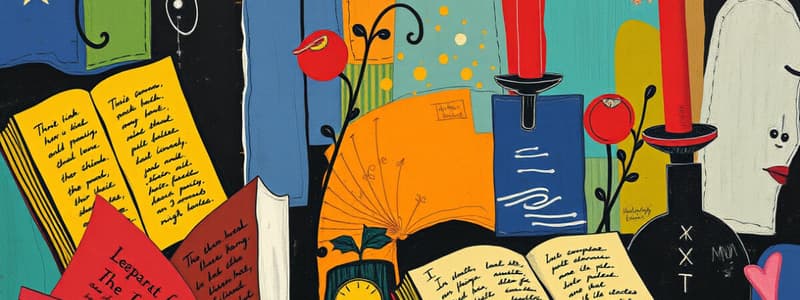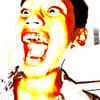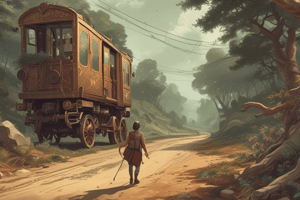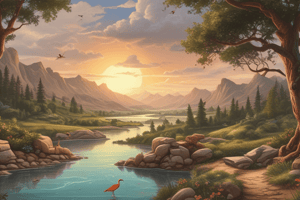Podcast
Questions and Answers
What is the main function of a plot in a story?
What is the main function of a plot in a story?
- To establish the mood
- To organize the sequence of events (correct)
- To create conflict
- To introduce characters
The protagonist is always a static character.
The protagonist is always a static character.
False (B)
What type of conflict involves a struggle within a character's own mind?
What type of conflict involves a struggle within a character's own mind?
Internal Conflict
The __________ is the highest point of interest or suspense in a story.
The __________ is the highest point of interest or suspense in a story.
Match the character types with their definitions:
Match the character types with their definitions:
Which of the following terms describes the atmosphere of a story?
Which of the following terms describes the atmosphere of a story?
Foreshadowing is used to provide clues about past events.
Foreshadowing is used to provide clues about past events.
What is direct characterization?
What is direct characterization?
The struggle between two opposing forces is known as ________.
The struggle between two opposing forces is known as ________.
Which part of the plot introduces the characters, setting, and conflict?
Which part of the plot introduces the characters, setting, and conflict?
What term refers to the central general message or main idea of a story?
What term refers to the central general message or main idea of a story?
Which part of a plot presents the events that lead to the highest point of interest?
Which part of a plot presents the events that lead to the highest point of interest?
What is the primary characteristic of a dynamic character?
What is the primary characteristic of a dynamic character?
What type of conflict occurs when a character faces a struggle with an external force?
What type of conflict occurs when a character faces a struggle with an external force?
What is the term for the overall atmosphere created by a writer in a story?
What is the term for the overall atmosphere created by a writer in a story?
Which of the following best describes indirect characterization?
Which of the following best describes indirect characterization?
What is foreshadowing used for in a plot?
What is foreshadowing used for in a plot?
What does the term 'antagonist' refer to in a story?
What does the term 'antagonist' refer to in a story?
Flashcards are hidden until you start studying
Study Notes
Fiction and Short Story
- Fiction refers to literary works stemming from the author's imagination.
- A short story is a concise piece of fiction typically ranging from 1-10 pages, often designed for a single sitting reading.
Key Literary Terms
- Plot: The structured sequence of events that unfolds within a story.
- Point of View: Perspective from which the story is narrated.
- Setting: The time and place where the story occurs.
- Characters: Individuals or entities (including animals) that engage in the narrative.
- Conflict: The essential struggle between opposing forces within the narrative; it drives the plot.
- Theme: The overarching message or central idea conveyed throughout the narrative.
- Mood: The emotional atmosphere evoked within the narrative.
- Tone: The writer's attitude towards the subject or audience, shaped by their choice of words and dialogue.
Structure of a Plot
- Exposition: Introduces key elements including characters, setting, and the primary conflict.
- Conflict: The central struggle that propels the narrative.
- Rising Action: Series of events that escalate due to the central conflict.
- Climax: The moment of highest interest or tension, where critical actions occur.
- Falling Action: Events that showcase the aftermath of the climax, leading towards resolution.
- Resolution: The conclusion where conflicts are resolved, and loose ends are tied up.
Types of Characters
- Protagonist: The main character who drives the story forward.
- Antagonist: A character or force that opposes the protagonist, creating conflict.
- Static Character: A character that remains the same throughout the story.
- Dynamic Character: A character that undergoes significant change due to story events.
Characterization
- Direct Characterization: The author explicitly describes character traits and personality.
- Indirect Characterization: Characteristics are revealed through the character's actions, thoughts, dialogue, and physical descriptions.
Types of Conflicts
- External Conflict: A struggle between a character and an outside force.
- Internal Conflict: A psychological struggle within a character's mind.
Literary Devices
- Flashback: A narrative tool that interrupts the current timeline to recount past events.
- Irony: A literary element where there is a discrepancy between what is expected and what actually occurs.
- Foreshadowing: The technique of dropping hints about future events in the story.
Fiction and Short Story
- Fiction refers to literary works stemming from the author's imagination.
- A short story is a concise piece of fiction typically ranging from 1-10 pages, often designed for a single sitting reading.
Key Literary Terms
- Plot: The structured sequence of events that unfolds within a story.
- Point of View: Perspective from which the story is narrated.
- Setting: The time and place where the story occurs.
- Characters: Individuals or entities (including animals) that engage in the narrative.
- Conflict: The essential struggle between opposing forces within the narrative; it drives the plot.
- Theme: The overarching message or central idea conveyed throughout the narrative.
- Mood: The emotional atmosphere evoked within the narrative.
- Tone: The writer's attitude towards the subject or audience, shaped by their choice of words and dialogue.
Structure of a Plot
- Exposition: Introduces key elements including characters, setting, and the primary conflict.
- Conflict: The central struggle that propels the narrative.
- Rising Action: Series of events that escalate due to the central conflict.
- Climax: The moment of highest interest or tension, where critical actions occur.
- Falling Action: Events that showcase the aftermath of the climax, leading towards resolution.
- Resolution: The conclusion where conflicts are resolved, and loose ends are tied up.
Types of Characters
- Protagonist: The main character who drives the story forward.
- Antagonist: A character or force that opposes the protagonist, creating conflict.
- Static Character: A character that remains the same throughout the story.
- Dynamic Character: A character that undergoes significant change due to story events.
Characterization
- Direct Characterization: The author explicitly describes character traits and personality.
- Indirect Characterization: Characteristics are revealed through the character's actions, thoughts, dialogue, and physical descriptions.
Types of Conflicts
- External Conflict: A struggle between a character and an outside force.
- Internal Conflict: A psychological struggle within a character's mind.
Literary Devices
- Flashback: A narrative tool that interrupts the current timeline to recount past events.
- Irony: A literary element where there is a discrepancy between what is expected and what actually occurs.
- Foreshadowing: The technique of dropping hints about future events in the story.
Studying That Suits You
Use AI to generate personalized quizzes and flashcards to suit your learning preferences.





